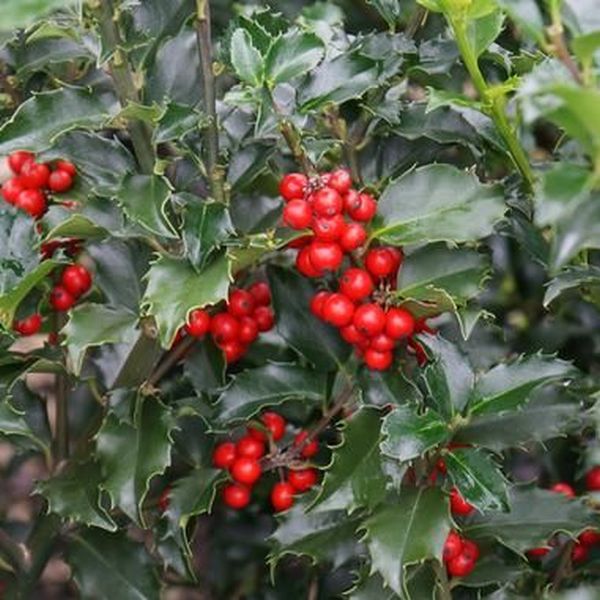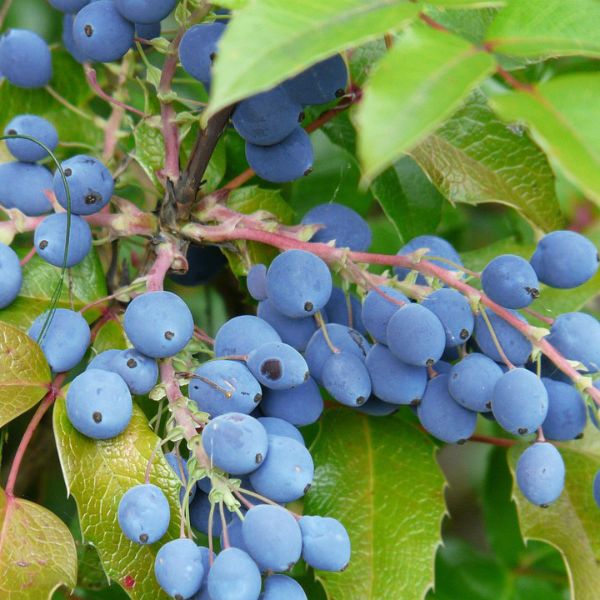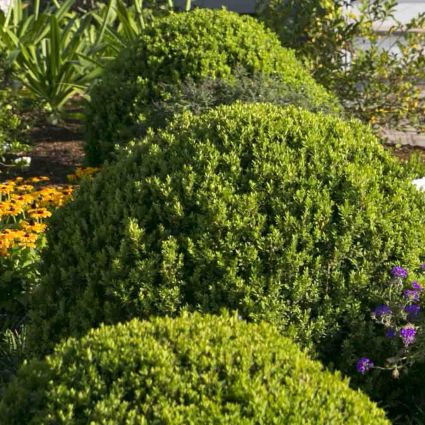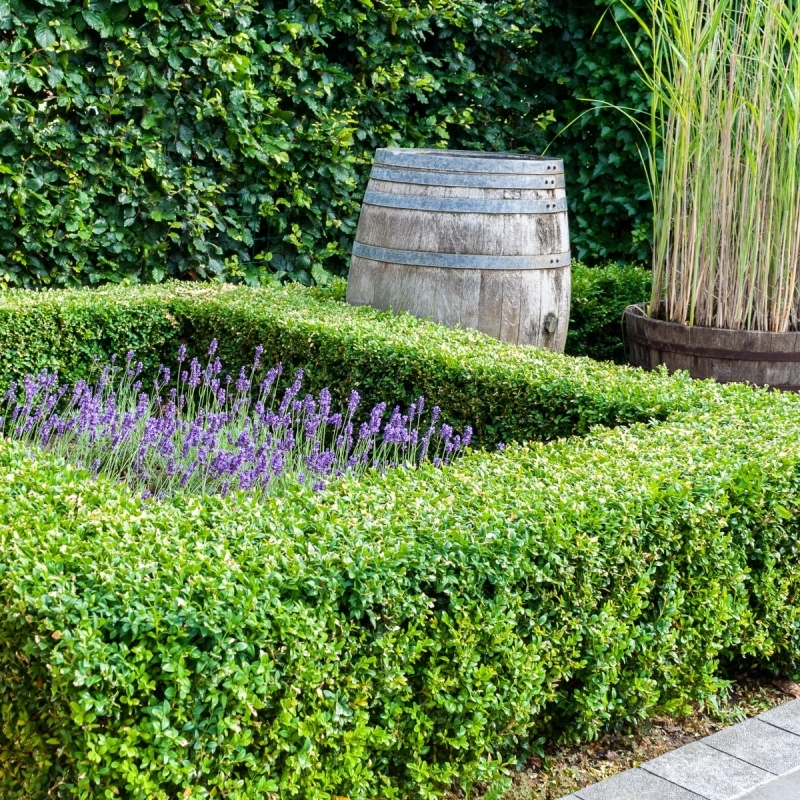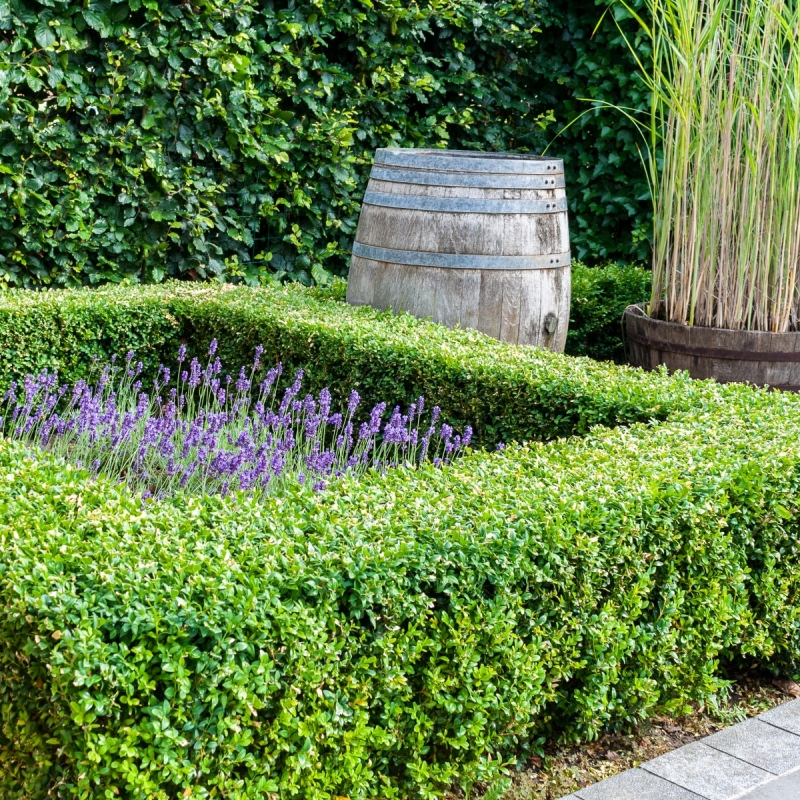

Dwarf Yaupon Holly
Ilex vomitoria 'Nana'
10 reviews
Dwarf Yaupon Holly
Ilex vomitoria 'Nana'
10 reviews
- 2.5 Gallon
- 1 Gallon
We are sorry, product is currently out of stock due to seasonal availability. Please check the "Related plants available in your area" section below
Not just beautiful - intentionally selected by ShrubHub's 3D landscape design team to fit real-world spaces and maximize yard potential.
Why Dwarf Yaupon Holly?
Dwarf Yaupon Holly (Ilex vomitoria 'Nana') is a popular shrub due to its compact size and low-maintenance nature. It is an excellent choice for small gardens or as a border plant. This holly species is drought-tolerant, disease-resistant, and requires minimal pruning. It adds year-round interest to the landscape with its dense evergreen foliage and bright red berries in winter.
Related plants available in your area
Sunlight
The Dwarf Yaupon Holly thrives in full sun to partial shade, with at least 6 hours of direct sunlight per day.
Watering
Dwarf Yaupon Holly has a moderate watering requirement and prefers well-drained soil. The plant should be watered regularly, especially during periods of drought, but be careful not to overwater as it can lead to root rot.
Fertilizing
The specific fertilizer requirement for Dwarf Yaupon Holly may vary, but a balanced fertilizer with a ratio of 10-10-10 or 14-14-14 is often recommended. It is best to follow the manufacturer's instructions and consult a local nursery or horticulturist for
Dwarf Yaupon Holly (Ilex vomitoria 'Nana')
Description
The Dwarf Yaupon Holly (Ilex vomitoria 'Nana') is a compact evergreen shrub with a rounded form. It belongs to the holly family, Aquifoliaceae, and is native to the southeastern United States.
Foliage
The foliage of the Dwarf Yaupon Holly is small, leathery, and glossy, creating a dense and lush appearance throughout the year. The leaves are dark green and elliptical with serrated edges.
Growth and Size
This yaupon holly cultivar grows slowly and maintains a compact size, making it an ideal choice for small gardens, borders, or foundation plantings. It typically reaches a mature height and spread of 2 to 3 feet, providing a tidy and low-maintenance option for landscaping.
Flowers and Berries
In spring, the Dwarf Yaupon Holly produces inconspicuous small white flowers, which are highly attractive to bees and other pollinators. Following the flowering period, female plants develop small black berries, adding visual interest to the shrub.
Light and Soil Requirements
This holly cultivar thrives in full sun to partial shade, although it can tolerate some shade as well. It is adaptable to a wide range of soil types, including well-drained sandy or clay soils. Once established, it also shows good drought tolerance.
Uses in Landscaping
The Dwarf Yaupon Holly is versatile and can be utilized in various landscaping applications. Its compact size and attractive foliage make it suitable for hedges, borders, mass plantings, or as a focal point specimen in smaller spaces. Additionally, this cultivar is often chosen for its low maintenance requirements and year-round interest.
Pruning and Maintenance
To maintain its neat appearance, the Dwarf Yaupon Holly benefits from occasional pruning. It should be pruned in late winter or early spring before new growth emerges. Regular trimming helps promote denser growth and can be used to control the overall shape and size of the shrub.
Winter Hardiness
This dwarf yaupon holly is generally hardy in USDA zones 7-9. It can withstand frost and freezing temperatures to some extent. In colder regions, providing a layer of mulch around the base of the plant can help protect the roots during winter.
Pest and Disease Resistance
The Dwarf Yaupon Holly is generally resistant to common pests and diseases. Its dense foliage and small leaves make it less susceptible to browsing by deer or other wildlife.
Caution
Despite its Latin species name 'vomitoria', it is important to note that the name is misleading as consumption of the berries may cause gastrointestinal distress; however, it is not actually considered toxic to humans.
Plant Information:
| Botanical Name: | Ilex vomitoria 'Nana' |
| USDA Zones: | 7 - 9 |
| Water: | Moderate |
| Exposure: | Full Sun |
| Soil Needs: | Widely Adaptable |
| Mature Height: | 3 - 5 feet |
| Mature Spread: | 3 - 6 feet |




Pollination Info
Pollination Info for Dwarf Yaupon Holly (Ilex vomitoria 'Nana')
Pollination Type:
The Dwarf Yaupon Holly (Ilex vomitoria 'Nana') is typically dioecious, which means it has separate male and female plants. Therefore, both male and female plants are required for pollination and fruit production.
Male Plants:
Male Yaupon Holly plants produce small, inconspicuous flowers that contain pollen. These flowers do not develop into fruits.
It is recommended to plant at least one male Yaupon Holly nearby to ensure adequate pollen for pollination.
Female Plants:
Female Yaupon Holly plants produce larger flowers that contain ovaries and potential fruits if pollinated.
Female plants need to be pollinated by nearby male plants to develop berries.
Pollination Process:
The pollination process in Yaupon Holly involves the transfer of pollen from the male flowers to the stigma of the female flowers.
This can be achieved through natural means like wind, or with the help of pollinators such as bees and other insects.
Fruit Production:
After successful pollination, female Yaupon Holly plants will produce small, round berries.
The berries are initially green and will turn red as they mature. They can persist on the plant throughout the winter, providing a source of food for birds and wildlife.
Cross-Pollination:
If you want to ensure a good berry production on your Dwarf Yaupon Holly, it is advisable to plant at least one male plant within the range of pollination.
Cross-pollination between a male and female plant will increase the chances of successful pollination and more abundant fruit set.
FAQ
Frequently Asked Questions - Dwarf Yaupon Holly (Ilex vomitoria 'Nana')
1. What is Dwarf Yaupon Holly (Ilex vomitoria 'Nana')?
Dwarf Yaupon Holly, scientifically known as Ilex vomitoria 'Nana', is a small evergreen shrub that belongs to the holly family. It is a compact variety of the Yaupon Holly native to the southeastern United States.
2. How tall does Dwarf Yaupon Holly (Ilex vomitoria 'Nana') grow?
The Dwarf Yaupon Holly typically grows up to 3 to 4 feet in height and spreads about 4 to 6 feet wide. Its small size makes it an excellent choice for small gardens, borders, or container planting.
3. Does Dwarf Yaupon Holly (Ilex vomitoria 'Nana') require full sun?
Yes, Dwarf Yaupon Holly thrives in full sun to partial shade. It prefers at least 6 hours of direct sunlight daily for best growth and foliage coloration. However, it can tolerate some shade as well.
4. What kind of soil does Dwarf Yaupon Holly (Ilex vomitoria 'Nana') prefer?
Dwarf Yaupon Holly is adaptable to a wide range of soil conditions. It prefers well-draining soil with a slightly acidic to neutral pH. However, once established, it can also tolerate clay, loam, or sandy soil types.
5. How often should I water Dwarf Yaupon Holly (Ilex vomitoria 'Nana')?
During the first year of planting, it's important to keep the soil consistently moist. Afterward, Dwarf Yaupon Holly becomes more drought-tolerant and requires watering only during prolonged dry periods. Avoid overwatering, as it can lead to root rot.
6. Does Dwarf Yaupon Holly (Ilex vomitoria 'Nana') need pruning?
Pruning is not necessary for the health of the plant, but it can be done to maintain a desired shape or size. The best time to prune Dwarf Yaupon Holly is in late winter or early spring before new growth begins.
7. Are the berries of Dwarf Yaupon Holly (Ilex vomitoria 'Nana') toxic?
Yes, the berries of Dwarf Yaupon Holly are mildly toxic if ingested. They can cause stomach discomfort, vomiting, or diarrhea if consumed in large quantities. It is advised to keep the plant away from children and pets.
8. Does Dwarf Yaupon Holly (Ilex vomitoria 'Nana') attract wildlife?
Yes, Dwarf Yaupon Holly produces small red berries that are attractive to birds, which feed on them. The plant also provides cover and nesting sites for birds, making it a valuable addition to wildlife gardens.
9. Is Dwarf Yaupon Holly (Ilex vomitoria 'Nana') deer resistant?
Yes, Dwarf Yaupon Holly is considered to be deer resistant. Deer tend to avoid holly plants due to their prickly leaves, making them a good choice for areas with deer populations.
10. Can Dwarf Yaupon Holly (Ilex vomitoria 'Nana') be used for hedges or screens?
Yes, the compact and dense growth habit of Dwarf Yaupon Holly makes it an excellent choice for hedges or screens. It can be pruned regularly to maintain the desired size and shape.
Planting & Care
Planting Instructions for Dwarf Yaupon Holly (Ilex vomitoria 'Nana')
The Dwarf Yaupon Holly is a compact, evergreen shrub that adds beauty to any landscape. Here are a few guidelines to ensure successful planting and care:
Planting:
- Choose a location with well-drained soil and partial to full sun exposure.
- Dig a hole that is slightly wider and just as deep as the root ball of the plant.
- Gently remove the plant from its container and loosen any tangled roots.
- Place the plant in the hole, making sure it is centered and at the same depth as it was in the container.
- Backfill the hole with soil, firming it gently around the roots.
- Water thoroughly to settle the soil and eliminate any air pockets.
- Apply a layer of mulch around the base of the plant to retain moisture and suppress weed growth.
Care:
To ensure the health and vitality of your Dwarf Yaupon Holly, follow these care instructions:
- Watering: Water deeply and regularly during the first year to establish a strong root system. Afterward, the plant is relatively drought-tolerant, but regular watering during dry spells is still beneficial.
- Fertilizing: Feed the shrub with a balanced, slow-release fertilizer in early spring before new growth appears. Follow the package instructions for dosage.
- Pruning: Prune sparingly to maintain the desired shape and size. It is best to prune immediately after the flowering period to avoid interfering with next year's blooms.
- Pest and Disease Control: The Dwarf Yaupon Holly is generally pest and disease-resistant. However, regular inspection for common garden pests and diseases is recommended. If necessary, treat with appropriate organic or chemical controls.
- Winter Protection: Although this variety is hardy, a layer of mulch around the base of the plant will help protect the roots from freezing temperatures.
By following these planting and care instructions, your Dwarf Yaupon Holly (Ilex vomitoria 'Nana') will flourish and provide year-round beauty to your garden.
Check Out These Verified Customer Reviews:
Customer Reviews
4.7 out of 5 based on 10 reviews
Thank you! Your review has been submitted.
The Dwarf Yaupon Holly plant arrived in perfect condition and was even more beautiful in person. The website was easy to navigate, and the shipment was quick. I highly recommend this plant!
Lovely addition to my garden, slightly delayed shipment.
Excellent customer service, very pleased with the purchase.
Item has been added to your cart.





